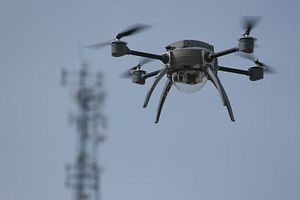Earlier this week, the Associated Press reported that Chinese engineers successfully tested a laser weapon capable of taking down a relatively slow-flying, low-altitude drone. Although one’s first impulse might be to tie this development in with broader trends in Chinese military technology and to assume that the weapon would eventually be used for defense against state military drones, Chinese state media claim that the laser system would eventually be used for counter-terrorism and domestic security purposes.
Xinhua‘s report covering the development earlier this week highlights the potential for terrorists to used drones mounted with light explosives as a potential attack vehicle in crowded public areas or during public events. Given the proliferation of cheap consumer drone technology, China suspects that homegrown terrorists might take to the skies. Where traditionally infantry or police armed with precision weaponry might be given charge of monitoring the skies for unwanted drones, a laser system ensures a significantly higher success rate in actually shooting down drones — at least in theory. Yi Jinsong, a manager with China Jiuyuan Hi-Tech Equipment Corp., told Xinhua that “intercepting such drones is usually the work of snipers and helicopters, but their success rate is not as high and mistakes with accuracy can result in unwanted damage.”
There is little reason to believe that claims that these lasers are intended for domestic security are a misdirection. Most importantly, Chinese state media reports have been forthright about the limitations of this anti-drone laser technology, noting that during testing it was only capable of successfully downing “various small aircraft within a two-kilometer radius.” This technology remains a far cry from threatening any real military-grade drones or other remotely piloted aircrafts (RPAs) which often cruise at higher altitudes (up to 50,000 ft in some cases). Xinhua notes that the system is characterized “by its speed, precision and low noise” — not its power or range. The system can target drones flying at up to 100 miles per hour. The Chinese engineers testing the system successfully shot down 30 drones with a 100 percent success rate, according to a statement from the China Academy of Engineering Physics (CAEP) cited by Xinhua.
The U.S. military successfully tested a truck-mounted laser with similar applications last year. Laser weaponry is effective in downing mobile aerial targets provided it can successfully lock on to a target. By focusing a high-energy beam on the chassis of the drone (or missile, as the case may be) for a prolonged duration, the weapon causes the target to crash or malfunction. In doing so, the laser weapon itself must resist any damage to its own structure. The implementation of laser technology tested by the United States last year had a remarkably successful trial run, and officials hailed it as a “big step in the development of targeted, high-energy laser beams that might also one day be used to defend U.S. airspace against, for example, fighter-jet or cruise-missile attacks.”
This Chinese system, once fully operationalized past the test phase, will likely find its way onto trucks for transportation and use at important public events and ceremonies. China’s investment in defense technologies for the purpose of domestic counter-terrorism highlights Beijing’s increasing concern with internal threats. Terrorism has been on the rise in China in recent years, particularly in the country’s restive western province of Xinjiang.
































